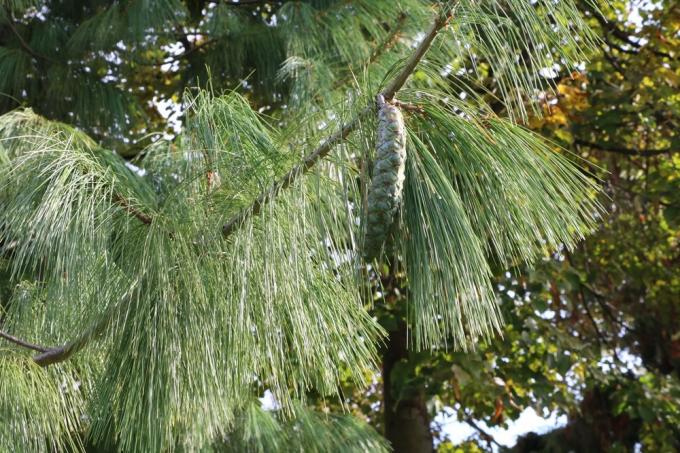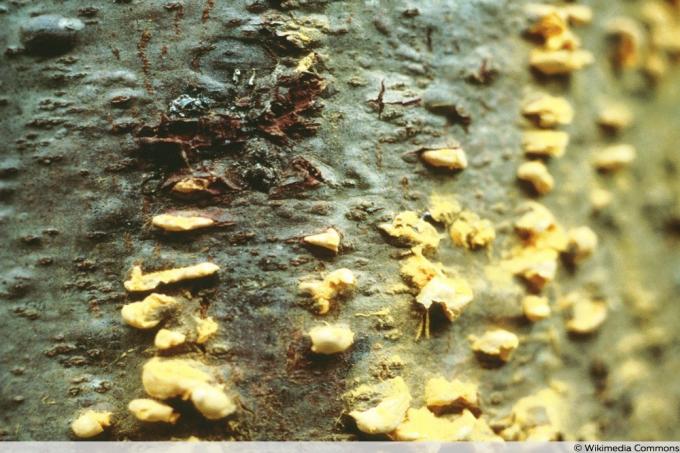
table of contents
- Location
- floor
- plants
- care
- to water
- Fertilize
- Cut
- Harvest time
- Overwinter
- Multiply
- Diseases and pests
Profile and care information open +conclude -
- Flower color
- yellow Red
- Location
- Sunny
- Heyday
- April May
- Growth habit
- upright
- height
- up to 35 meters high (a little less in the garden)
- Soil type
- sandy, loamy
- Soil moisture
- moderately dry, moderately moist, very moist
- PH value
- neutral, slightly acidic, acidic
- Limescale tolerance
- Calcium intolerant
- humus
- rich in humus
- Poisonous
- no
- Plant families
- Pine family, Pinaceae
- Plant species
- Conifers, ornamental trees
- Garden style
- Natural garden, park
The teardrop pine is considered to be one of the most beautiful ornamental trees. The conifer owes this reputation to its long needles with a bluish-gray color and its imposing cones. Although the teardrop pine is not native to us, it thrives splendidly in many regions. In public green spaces you will find specimens over 20 meters high and up to 12 meters wide. But don't worry, there are also smaller varieties for the garden and terrace.
Location

The teardrop pine prefers a sunny, sheltered location. It is sensitive to cold winter winds. The Wallich Pine thrives best as a specimen plant when it has a lot of space. That is why the conifer is often found in parks.
Smaller varieties are recommended for your own garden, such as the “Zebrina” variety, because it is a maximum of 20 meters high and 12 meters wide. But there are also varieties that are kept in a large bucket on the terrace or on the roof garden. For example, the “Densa Hill” variety is only seven meters high and two meters wide.
floor
The teardrop pine grows on almost all soils. Ideally, the lacrimal pine will find a soil with the following properties:
- sandy-loamy
- pH value: 5.0 to 6.5
- slightly dry to moist
- shallow to very profound
- not too calcareous
- permeable (sensitive to waterlogging)
Tip: In compacted, heavy soils made of clay or loam, you should work in plenty of sand as drainage so that the roots do not begin to rot.
plants

Source: Agnieszka Kwiecień, Nova, Pinus wallichiana Sosna himalajska 2010-06-11 01, Edited by Gartenlexikon.de (MKr), CC BY-SA 4.0
The optimal time for planting Wallich pine is between March and October. In summer, however, you should make sure that the temperature does not exceed 30 degrees Celsius. Because in these hot periods the freshly planted teardrop pine gets too little water. To plant in the garden, follow the instructions below:
- Remove stones and weeds from the ground
- Loosen up the earth
- Dig the planting hole
- Width and depth: twice the diameter of the root ball
- Place the Himalayan pine in the planting hole
- fill up with soil
- kick down
- water well
Planting instructions for the container culture
- Choose a deep planter with a drainage hole
- Distance between the root ball and the edge of the vessel: 2 to 3 centimeters
- Lay a drainage layer of gravel and / or potsherds at the bottom of the planter
- Cover the drainage layer with soil
- Insert the jaw
- fill up with soil
- press firmly
- water well
- Plant neighbors
Tip: The Himalayan pine comes into its own as a solitaire.
care

In terms of care, you can treat Wallich pines in the same way as other pines. In general, however, the Himalayan pine is easy to handle. Since it makes hardly any demands on the soil, the most important measure in maintenance is to ensure an adequate supply of water.
to water
Although the teardrop jaw is sensitive to too much moisture, it must not dry out completely. Therefore you should provide Pinus wallichiana with sufficient water in spring and summer during longer dry periods as part of maintenance.
Fertilize
A special coniferous fertilizer is recommended for fertilization. At the beginning of the growth phase you should fertilize the Himalayan pine with a slow release fertilizer. The end of the fertilizing season is at the beginning of August. Potash fertilization is recommended for September because this care makes the conifer more resistant to frost and cold.
Cut
Since Pinus wallichiana does not tolerate pruning very well, you should not cut the tree unnecessarily. If, for example, the tip is cut, two tips usually grow back. You should also be careful when cutting branches so that the tree does not lose its shape. Under no circumstances should you cut into the old wood, because the Himalayan pine only sparsely sprouts here, if at all. Therefore, you should only use dead, broken and possibly. remove diseased branches.
Harvest time

The cones are used in floristry and as a decorative element. However, they are heavily coated with a white resin, which is why they are extremely sticky when harvested. The cones, which gave the conifer the name "teardrop pine", grow in groups of up to six.
Overwinter
The teardrop pine is considered to be moderately frost hardy, i.e. it can withstand temperatures between minus 12.3 to a maximum of minus 17.8 degrees Celsius. This corresponds to winter hardiness zone 7. During winter care, you should make sure that the lacrimal jaw is supplied with sufficient water even in the cold season. That is why you should water the conifer in dry winters. However, watering is only done on frost-free days. Since it is very sensitive to broken snow, you should shake off wet snow regularly. In young lacrimal pines, it is advisable to tie the branches together.
Tip: When choosing a location outdoors, you should note that Pinus wallichiana does not tolerate winter sun, especially at a young age.
Winter in the bucket
Plants that are kept in the tub are less resistant to frost and cold, as these can penetrate through the walls of the tub. This is why the lacrimal jaw needs winter protection when it is cultivated in a bucket. Ideally, the conifer is well wrapped from all sides:
Cover the bucket with a cold protection fleece
- Against the cold from below: place the bucket on a thick wooden board or a styrofoam plate
- Against the cold from above: Cover the ground with a fleece or jute
Tip: When protecting against the cold from above, you should keep in mind that the teardrop pine must also be watered in winter.
Furthermore, you should move the teardrop jaws close to a house wall that is heated from the inside, because this radiates additional heat. Since the plants cannot tolerate waterlogging, you should also protect them from rain and snow.
Multiply

Source: Camera: Star louse, Photo: birdy geimfyglið(:> )=|, Tree grown: birdy geimfyglið(:> )=| & Star louse, Himalayanafura (Pinus wallichiana) 9months, Edited by Gartenlexikon.de (MKr), CC BY-SA 3.0
You can propagate Pinus wallichiana with seeds. In order to stimulate the seeds of the teardrop pine to germinate, a cold-wet stratification is recommended. Proceed according to the following instructions:
- Wrap the seeds in a slightly damp cloth
- Put the cloth and seeds in a plastic bag
- Put a straw in the plastic bag (oxygen supply)
- Place plastic bags in the refrigerator for three months (4 to 6 degrees Celsius)
To see if germination was successful, you should check the seeds regularly. If the seeds are torn open and roots can be seen, then you can put the seeds in the soil.
An alternative stratification is described as follows:
- Store seeds for three months at four to six degrees Celsius
- Soak in water for 24 hours before planting
So that the germinating seeds develop well, they come in a well-drained substrate. If the young lacrimal pines are grown in the pot, then this should have sufficient depth so that the main root, which grows deeper, does not wither. The planting depth is about half a centimeter. In the next few weeks, make sure that the soil does not dry out completely. If the conditions are right, you should see the first green after two to three weeks at the earliest.
Tip: Teardrop pine seeds can be kept for up to a year if they are stored in a cool (15 to 18 degrees Celsius), dry and dark place.
Diseases and pests

Source: US Forest Service photo [1] [Public domain], Cronartium ribicola 1, Edited by Gartenlexikon.de (MKr), CC0 1.0
If it is too dry, the needles turn yellow and fall off. In the case of spring drought, the damage shows up in the same year. In the case of summer drought, the damage is often only visible in the following years.
Blister rust
The teardrop pine is prone to bladder rust (Cronartium ribicola). Since the fungus "shuttles" between currants and pine, you should not cultivate the two plants together. However, this does not banish the danger, because the spores can infect the jaw up to a distance of two kilometers.
Pine chute
Often, pine chutes also occur in the teardrop jaw. The cause of the sudden dropping of the needles can be fungal or physiological.
Leaf bugs and spider mites
These pests, while annoying, do not cause any major damage.

